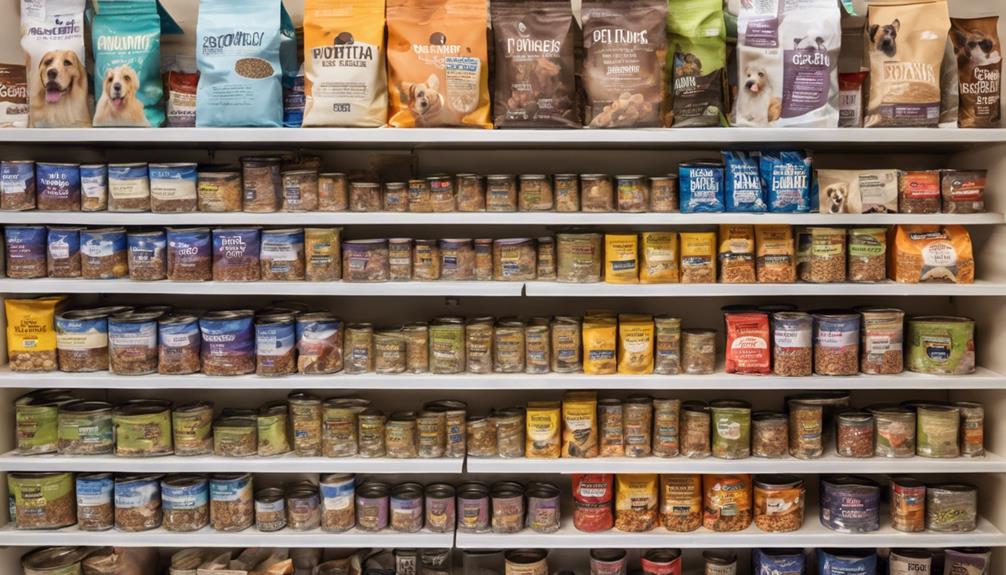Selecting the Best Dog Food: Top Tips
When it comes to selecting the best dog food, think of it as choosing the key to your furry companion's well-being. With a market flooded with options, how do you ensure you're making the right decision for your dog's health and happiness?
Let's explore essential tips that will help you navigate this crucial decision with confidence and care. Remember, your dog's diet plays a significant role in their overall quality of life.
So, let's delve into the world of dog nutrition and make informed choices together.
Nutritional Needs of Dogs
When selecting the best dog food, you should consider the specific nutritional needs of your canine companion. Dogs require high-quality protein sources in their diet to support muscle growth and maintenance. Look for dog foods that list real meats like chicken, beef, or fish as the first ingredients on the label. These protein sources are essential for your dog's overall health.
In addition to protein, digestible carbohydrates are also important for dogs. Carbohydrates provide a source of energy and fiber, aiding in digestion. When choosing a dog food, opt for ones that include whole grains like brown rice or oats. Avoid foods with excessive amounts of fillers like corn or wheat, as these may be harder for your dog to digest.
Reading Dog Food Labels
To effectively choose the best dog food for your furry friend, it's crucial to understand how to read and interpret dog food labels. When looking at dog food labels, focus on the ingredient analysis. Ingredients are listed by weight, so the first few items are the most prominent in the food. Look for high-quality protein sources like chicken or beef listed at the beginning. Avoid foods with fillers like corn or by-products as main ingredients.
Additionally, brand comparison is essential when reading dog food labels. Different brands have varying standards for ingredient quality and sourcing. Research the reputation of the brand and check for any recalls or controversies related to their products. Some brands prioritize using natural and organic ingredients, which might be beneficial for your dog's health.
Avoiding Harmful Ingredients
Focus on identifying harmful ingredients in dog food labels by checking for common additives like artificial preservatives, colors, and flavors. When analyzing the ingredients list, keep an eye out for substances that could potentially harm your furry friend. Here are some key points to consider:
- Ingredient Analysis: Look for specific ingredients such as BHA, BHT, ethoxyquin, propylene glycol, and artificial colors like Red 40 and Yellow 5. These additives have been linked to various health issues in dogs.
- Health Implications: Artificial preservatives like BHA and BHT have been associated with cancer and other serious health conditions in canines. Artificial colors can cause allergic reactions and behavioral problems in some dogs.
- Questionable Ingredients: Ingredients labeled as 'meat by-products' or 'animal digest' may contain low-quality proteins and unidentified sources, potentially affecting your dog's overall health.
- Natural Alternatives: Opt for dog foods with natural preservatives like tocopherols (Vitamin E) or rosemary extract, and real meat as the primary protein source to ensure a healthier diet for your pet.
Considering Your Dog's Age
Take into account your dog's age when selecting the most suitable food for their nutritional needs. Puppies, for example, require a higher concentration of nutrients to support their growth and development. Therefore, opting for puppy food specifically formulated for their needs is essential. These formulas provide the necessary balance of proteins, fats, vitamins, and minerals crucial for their early stages of life.
As dogs age, their dietary requirements change. Senior dogs may have dietary restrictions or require special diets due to health conditions. In such cases, it's crucial to choose food that caters to their specific needs. Some breeds may benefit from breed-specific formulas that cater to their unique nutritional requirements. These formulas take into account the breed's size, metabolism, and potential health predispositions.
When deciding on the best food for your dog, consider their age, any dietary restrictions they may have, special diets they might require, and whether breed-specific formulas or puppy food would be most suitable. Prioritizing your dog's age and specific nutritional needs will help ensure they lead a healthy and happy life.
Choosing Between Wet and Dry Food
Considering your dog's age and nutritional needs, the choice between wet and dry food plays a crucial role in providing them with the right balance of nutrients. When deciding between the two options, take into account your furry friend's preferences and what suits your lifestyle best.
Here are some factors to consider:
- Texture Preference: Some dogs might prefer the softer texture of wet food, while others enjoy the crunch of dry kibble.
- Palatability: Wet foods are often more aromatic and flavorful, which can be enticing for picky eaters.
- Storage Convenience: Dry food is easier to store and can be left out for longer periods without spoiling.
- Shelf Life: Dry food generally has a longer shelf life once opened, making it more convenient for households with one or few pets.
Consulting With a Vet
When seeking guidance on selecting the best dog food, consulting with a vet is essential to ensure your furry companion's nutritional needs are met. Vets can provide valuable insights into your dog's specific dietary restrictions and special diets. They can assess your dog's health status, age, breed, and any underlying medical conditions that may impact their dietary requirements. Vets can recommend the right balance of proteins, carbohydrates, fats, vitamins, and minerals to keep your dog healthy and active.
If your dog has allergies or intolerances, a vet can help identify potential triggers and suggest suitable food options. Additionally, if your dog requires a special diet due to weight management, joint issues, or other health concerns, a vet can tailor recommendations to meet these specific needs. By consulting with a vet, you can make informed decisions about the best dog food that aligns with your pet's overall well-being. Remember, your vet is your best ally in ensuring your dog receives the proper nutrition for a long and happy life.
Budget-Friendly Options

To make sure you're providing quality nutrition without breaking the bank, exploring budget-friendly options for your dog's food can be a smart move. When looking for affordable dog food, consider the following options:
- Homemade recipes: Making your dog's food at home can be cost-effective and allows you to control the ingredients, ensuring your furry friend gets a nutritious meal without the hefty price tag.
- Grain-free options: Opting for grain-free dog food can sometimes be more budget-friendly than you think. Many brands offer affordable grain-free formulas that cater to your dog's dietary needs without compromising on quality.
- Store-brand alternatives: Don't overlook store-brand dog foods. They often provide adequate nutrition at a lower cost compared to premium brands, helping you save money while still giving your dog a balanced diet.
- Bulk buying: Purchasing dog food in bulk quantities can lead to significant savings in the long run. Look for deals on larger bags or cans to reduce the cost per serving and keep your budget in check.
Transitioning to a New Food
Transitioning your dog to a new food requires a gradual adjustment to prevent digestive issues and ensure a smooth dietary change. Start by slowly transitioning from the old food to the new one over about a week. Begin by mixing a small amount of the new food with the old food, gradually increasing the ratio of new to old food each day. This slow transition helps your dog's digestive system adapt to the new ingredients without causing stomach upset.
Another helpful tip when transitioning to a new food is taste testing. Dogs can be picky eaters, so it's essential to make sure they enjoy the new food. Before fully switching, offer your dog a small sample of the new food to see if they like the taste. If your dog seems hesitant, you can try mixing in some wet food or low-sodium broth to entice them.
Frequently Asked Questions
How Can I Determine if My Dog Has Any Specific Food Allergies or Sensitivities?
To figure out if your dog has food allergies or sensitivities, start with an elimination diet. Consult your vet for guidance. They may recommend allergy testing or ingredient rotation to identify the culprit.
Are There Any Specific Feeding Guidelines or Portion Control Recommendations for Different Breeds or Sizes of Dogs?
When it comes to feeding your furry friend, it's crucial to consider breed-specific diets and portion recommendations. Different breeds and sizes of dogs have varying feeding guidelines. Larger breeds may require more food, while smaller breeds might need smaller portions.
Always consult with your veterinarian to determine the best feeding plan for your dog based on their specific breed and size. Proper portion control is essential to keep your dog healthy and happy.
What Is the Best Way to Introduce New Foods or Treats to My Dog's Diet Without Causing Stomach Upset?
When introducing new foods or treats to your dog's diet, start with a slow transition. Gradually incorporate the new items to promote digestive health.
Monitor your dog's reactions closely during this process. By taking it step by step, you can help prevent stomach upset and ensure your furry friend adjusts well to the changes in their diet.
Can Certain Ingredients in Dog Food Contribute to Dental Health or Promote Overall Oral Hygiene?
Certain ingredients in dog food can contribute to dental health by promoting oral hygiene benefits. Ingredient analysis plays a crucial role in selecting dog food that supports your pet's dental health.
Look for formulas with ingredients like antioxidants, omega-3 fatty acids, and specific minerals that can help reduce plaque buildup and maintain oral hygiene. Choosing the right dog food can positively impact your furry friend's dental well-being.
How Can I Ensure That My Dog Is Getting Enough Hydration Through Their Diet, Especially if They Primarily Eat Dry Food?
To ensure your dog stays hydrated when they mainly eat dry food, consider adding wet food to their diet. Wet food has higher water content, aiding in hydration balance.
Monitor their water consumption closely to meet their nutritional needs. Mixing dry and wet food can help maintain their hydration levels.
Conclusion
In conclusion, selecting the best dog food for your furry friend is crucial for their health and well-being. By understanding your dog's nutritional needs, reading labels, and avoiding harmful ingredients, you can make an informed decision. Consulting with a vet and considering your dog's age will also help you choose the right food.
Remember to transition slowly to a new food to prevent any digestive issues. Your dog will thank you for providing them with a nutritious and delicious diet.
